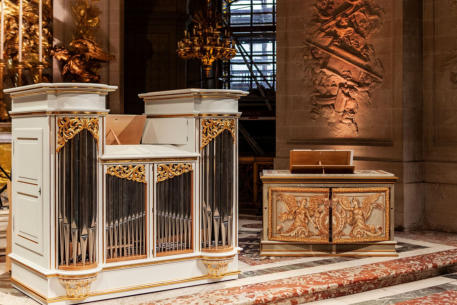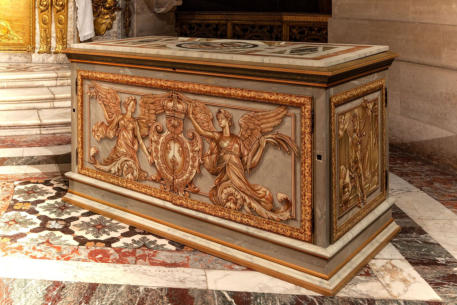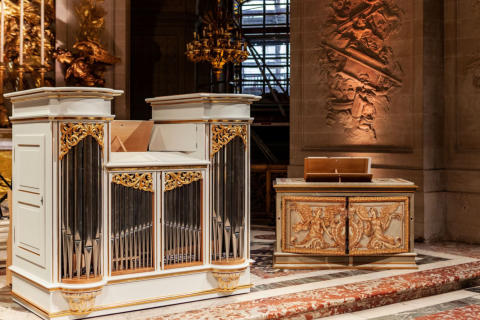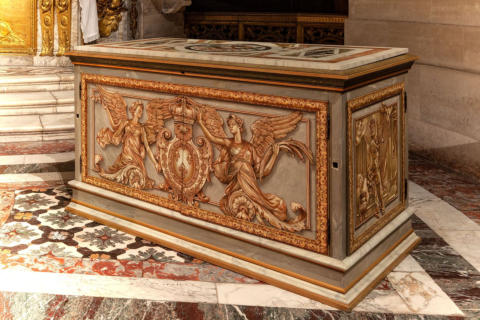



ORGANS OF PARIS © 2024 Vincent Hildebrandt HOME ALL ORGANS
Versailles, chateau
1 Place Léon Gambetta, 78000 VersaillesChâteau de Versailles Spectacles
Cabinet de Mme Adelaïde >
Chapelle royal>
Positive organ - Portative organ
Positive organ 2017 - Quentin BlumenroederII/8 - traction mécanique


Portative organ
- Bourdon 8' in wood
- Principal 8’ in tin
- Flûte principalisante 4’ in wood
- Dessus de Quinte 2’ ⅔ in tin
- Doublette 2' in tin or
- Régale 8’ in tin
The case is made of polychrome poplar wood. This
work was done by Antoine Fontaine.
The keys of the keyboard are made of spruce wood.
The natural keys are veneered with ebony, the sharps
are made of bone.
A small decoration has been made on the pediments
of the keys.

Portative organ
2013 - Quentin Blumenroeder
II/8 - traction mécanique
Premier clavier
- Principal 8’ in tin – 1st octave from Bourdon 8'
- Prestant 4’ in tin
- Quinte 3’ in tin
- Basson 8’ C - c’ in tin à 415 Hz
Deuxième clavier
- Bourdon 8’ in lead– 1st octave in wood
- Flûte à cheminée 4’ in tiin
- Doublette 2’ in tin
- Régale 16’ or 8’ in tin
- Coupler II/I
- Tirasse I or II
The two 53-note manuals (CD-f'''), whose naturals are
veneered with amourette wood and the feints in
boxwood, can be transposed into 392, 415, 440, 465 Hz
tuning forks. The 29-note pedalboard can be transposed
to 392 and 415 Hz.
Source
The instrument is made on the basis of an organ that we
restored for the Musée des Arts Décoratifs of the City of
Strasbourg. This historic organ, built by André
Silbermann in 1719, was installed in 1730 at the convent
of Saint-Joseph (Tierceline Sisters) in the town of
Haguenau (67), by Jean-André Silbermann.
The project, based on the concerts presented at the
Palace of Versailles, consists of placing the Grand Orgue
at the centre of the orchestra. Indeed, the small
positives called "chests", usually used, have nothing
historical about them, at least not for large-scale music
or religious music. They are, most of the time, dedicated
to salon music in the eighteenth and even at the end of
the seventeenth century. The organ was built to have a
very dynamic instrument, with a rich palette of colors, by
applying three sound planes, one of which is drawn.
There are many testimonies about the fact that you can
vary the continuo from the smallest Bourdon to the
large 16 foot reed with the pedal. We have therefore
designed and built an organ on the basis of a large
positive that allows, despite everything, to be moved
and tuned according to temperature variations and in
the different temperaments required by the musicians.
It is obvious that it will take some time before this
instrument is tamed by concert performers who will
have to adapt their habits and probably look for
different ways of using registers in historical texts
according to the moments and the musical numbers.
Various devices have been provided to facilitate the
tuning of the pipes, including the fact that the regal's
shavers come out of the box that surrounds it, so that it
can be tuned even if it is closed.
This instrument - dedicated to the continuo, with its
couplings and pedalboard, thus becoming much richer,
in particular with the bassoon bass (made after a
Silbermann model measured in the nineteenth century)
or with the presence of a 16' - is nevertheless a
concertante instrument, even allowing to approach the
organ repertoire.
Organs of Paris
ORGANS OF PARIS © 2024 Vincent Hildebrandt ALL ORGANS
Versailles, chateau
1 Place Léon Gambetta, 78000 VersaillesChâteau de Versailles Spectacles
Cabinet de Mme Adelaïde >
Chapelle royal>
Positive organ - Portative organ
Positive organ 2017 - Quentin BlumenroederII/8 - traction mécanique

Premier clavier
- Principal 8’ in tin – 1st octave from Bourdon 8'
- Prestant 4’ in tin
- Quinte 3’ in tin
- Basson 8’ C - c’ in tin à 415 Hz
Deuxième clavier
- Bourdon 8’ in lead– 1st octave in wood
- Flûte à cheminée 4’ in tiin
- Doublette 2’ in tin
- Régale 16’ or 8’ in tin
- Coupler II/I
- Tirasse I or II
The two 53-note manuals (CD-f'''), whose naturals are
veneered with amourette wood and the feints in boxwood,
can be transposed into 392, 415, 440, 465 Hz tuning forks.
The 29-note pedalboard can be transposed to 392 and 415
Hz.
Source
The instrument is made on the basis of an organ that we
restored for the Musée des Arts Décoratifs of the City of
Strasbourg. This historic organ, built by André Silbermann in
1719, was installed in 1730 at the convent of Saint-Joseph
(Tierceline Sisters) in the town of Haguenau (67), by Jean-
André Silbermann.
The project, based on the concerts presented at the Palace of
Versailles, consists of placing the Grand Orgue at the centre
of the orchestra. Indeed, the small positives called "chests",
usually used, have nothing historical about them, at least not
for large-scale music or religious music. They are, most of the
time, dedicated to salon music in the eighteenth and even at
the end of the seventeenth century. The organ was built to
have a very dynamic instrument, with a rich palette of colors,
by applying three sound planes, one of which is drawn.
There are many testimonies about the fact that you can vary
the continuo from the smallest Bourdon to the large 16 foot
reed with the pedal. We have therefore designed and built an
organ on the basis of a large positive that allows, despite
everything, to be moved and tuned according to temperature
variations and in the different temperaments required by the
musicians. It is obvious that it will take some time before this
instrument is tamed by concert performers who will have to
adapt their habits and probably look for different ways of
using registers in historical texts according to the moments
and the musical numbers.
Various devices have been provided to facilitate the tuning of
the pipes, including the fact that the regal's shavers come out
of the box that surrounds it, so that it can be tuned even if it
is closed.
This instrument - dedicated to the continuo, with its couplings
and pedalboard, thus becoming much richer, in particular
with the bassoon bass (made after a Silbermann model
measured in the nineteenth century) or with the presence of
a 16' - is nevertheless a concertante instrument, even
allowing to approach the organ repertoire.

Portative organ
- Bourdon 8' in wood
- Principal 8’ in tin
- Flûte principalisante 4’ in wood
- Dessus de Quinte 2’ ⅔ in tin
- Doublette 2' in tin or
- Régale 8’ in tin
The case is made of polychrome poplar wood. This work was
done by Antoine Fontaine.
The keys of the keyboard are made of spruce wood. The
natural keys are veneered with ebony, the sharps are made of
bone.
A small decoration has been made on the pediments of the
keys.





















